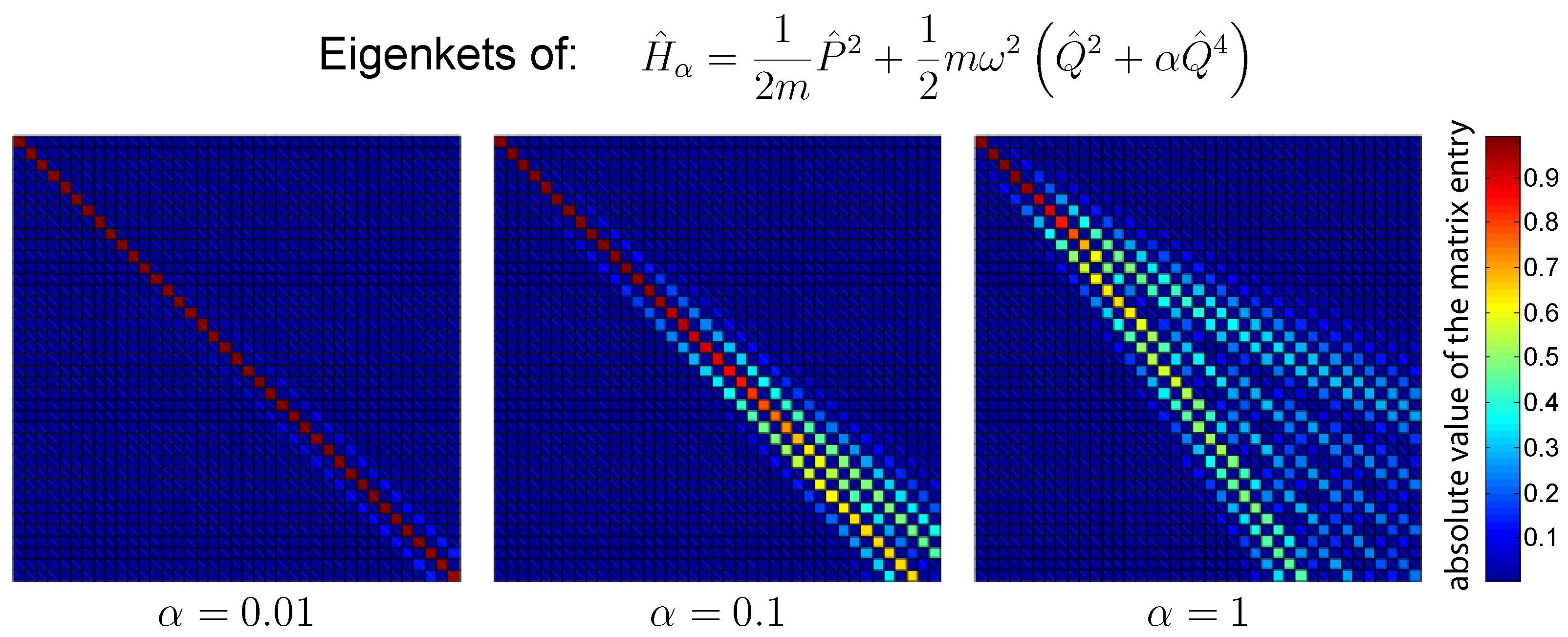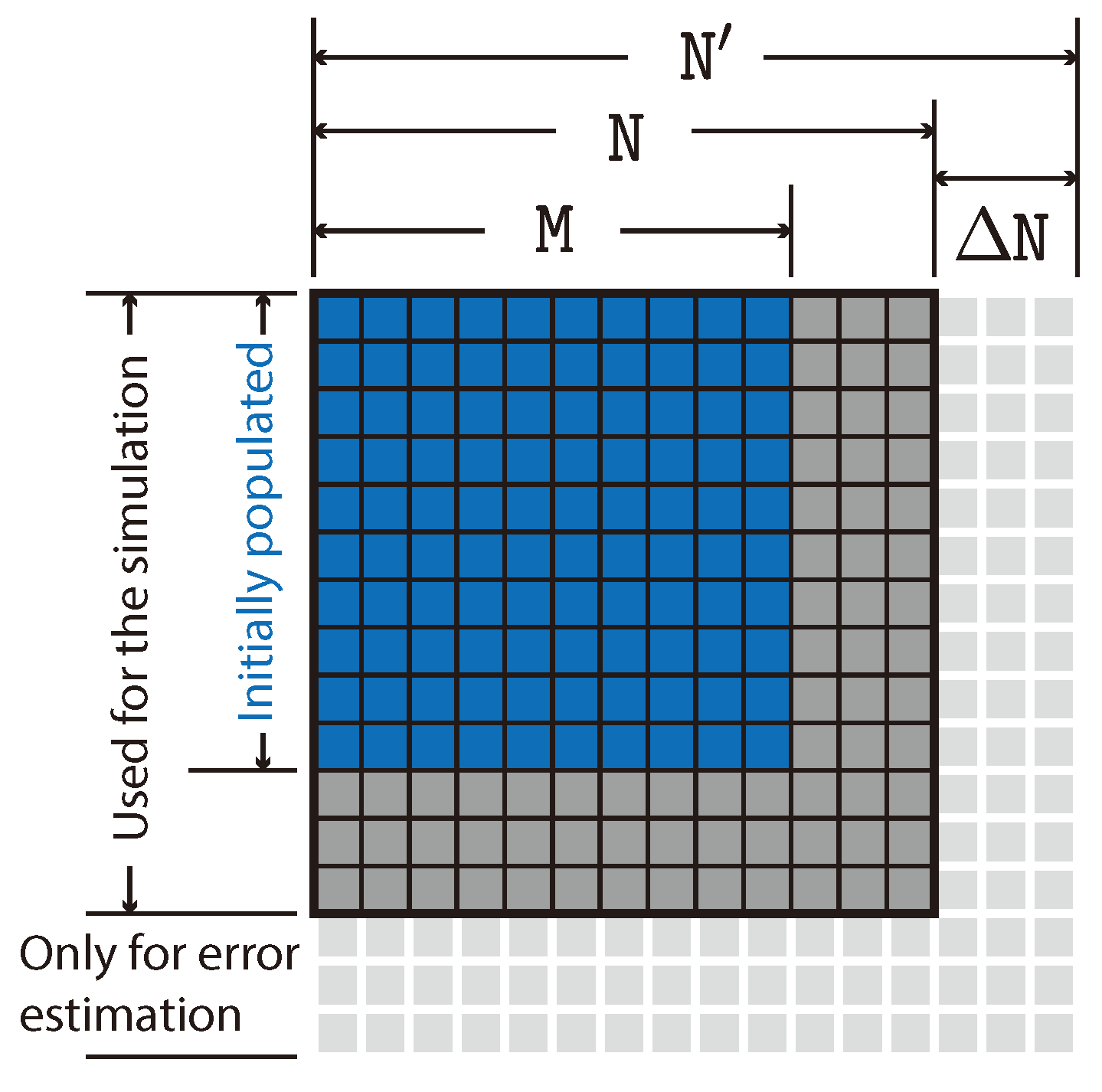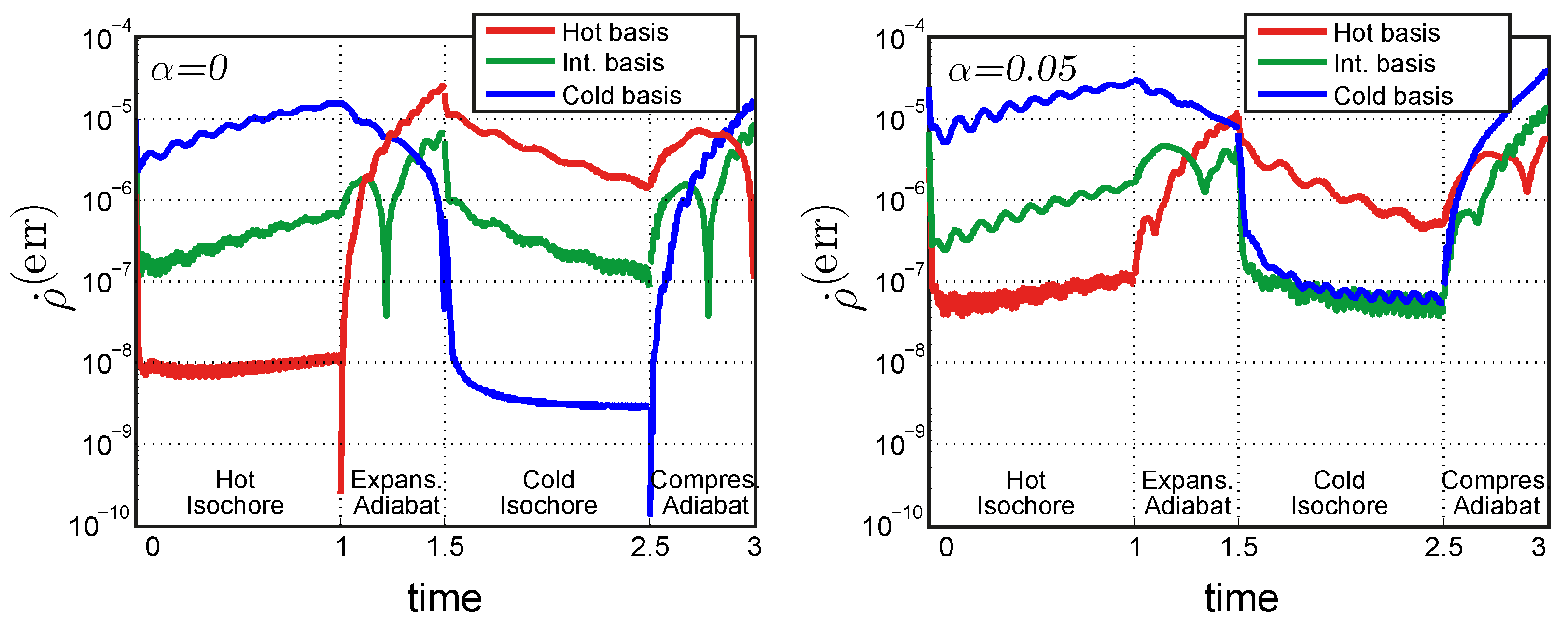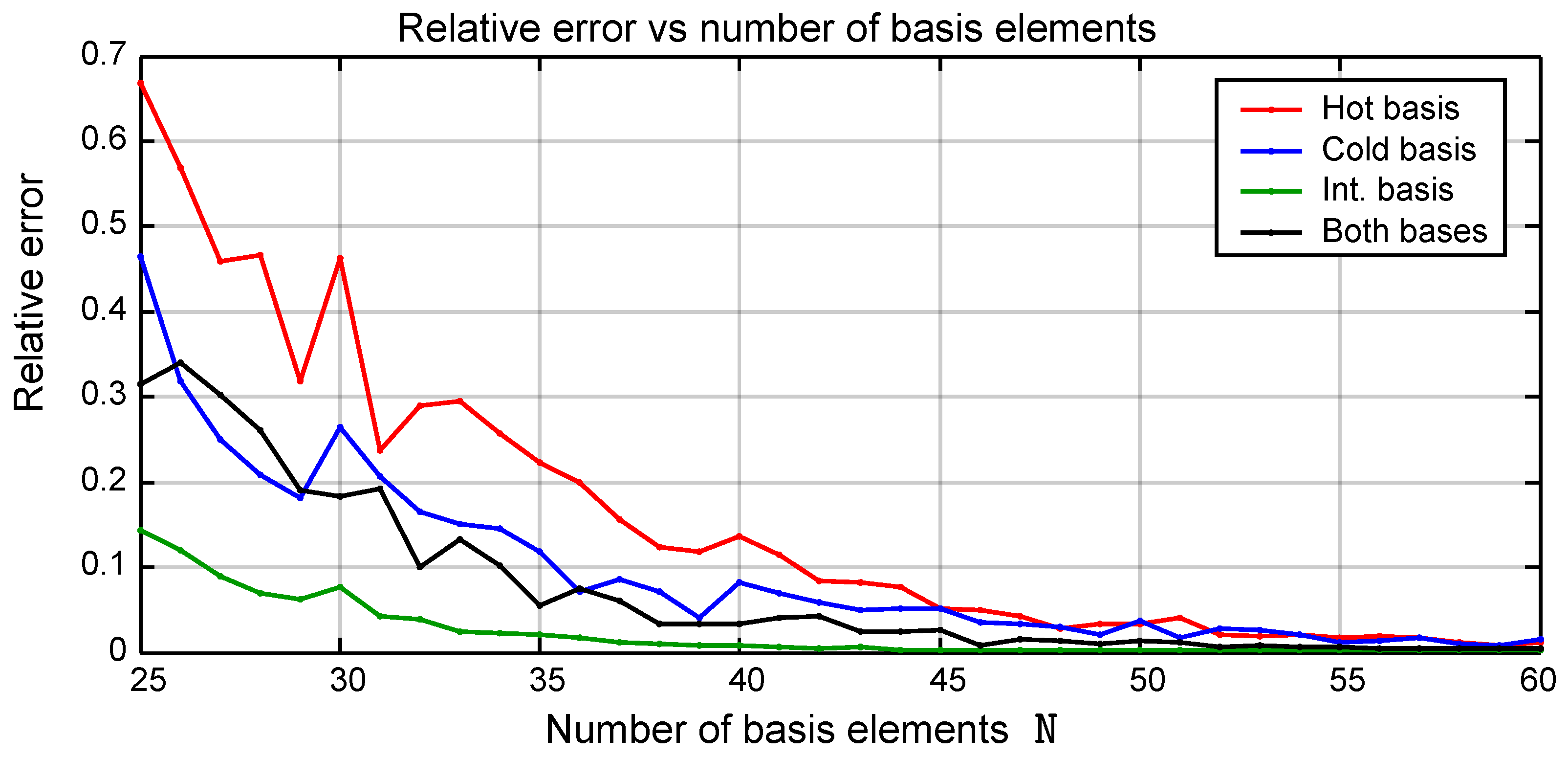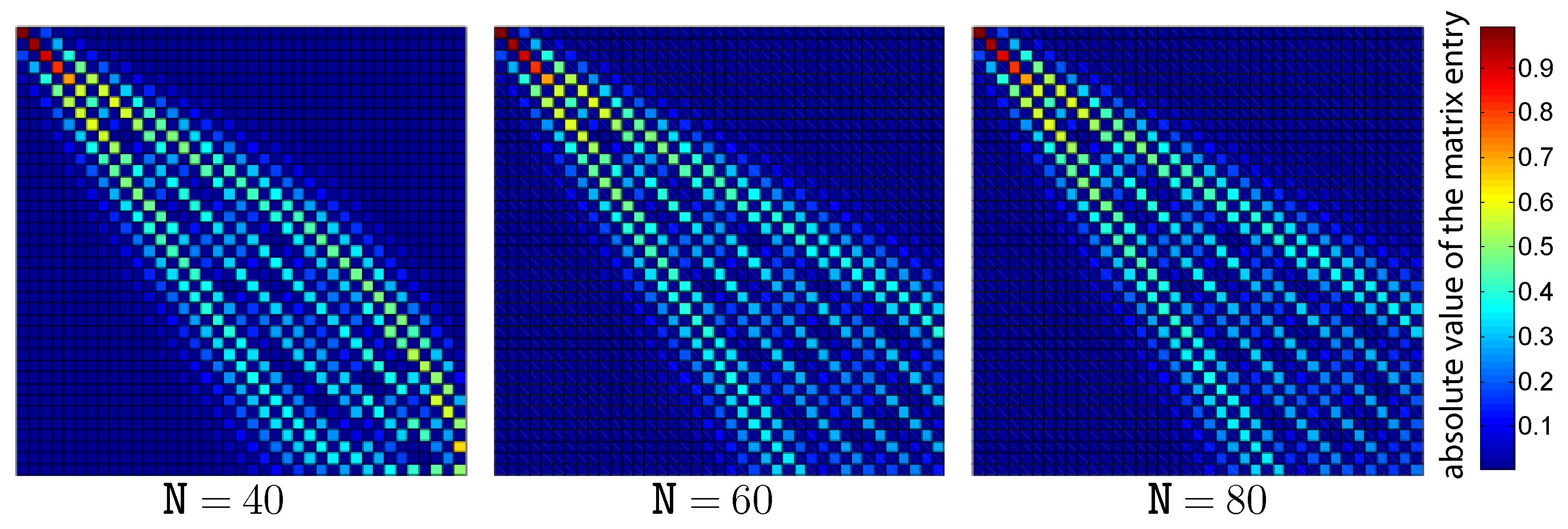3.1. Expansion Equations
In some cases, the most studied being the harmonic case, there exists a useful property that allows one to represent the state of the system with a finite number of scalar parameters [
16]. A finite set of Hermitian operators
has to be found so that the two following properties are fulfilled:
The set forms a
Lie algebra, i.e., is closed under the application of the commutator between any pair of operators:
The algebra is closed under the application of
and
. For
, this requirement means that it is possible to write the Hamiltonian operator
as a linear combination with real coefficients of the operators in the set,
For
, the closure requirement leads to additional conditions on the Lindblad operators
and
[
16].
When these conditions are met,
canonical invariance holds and it is possible to represent the state of the system with a finite number of parameters for the whole evolution [
16]. This representation is different for the Schrödinger and Heisenberg formalisms.
In the Schrödinger formalism, the density operator is time dependent. Because of canonical invariance, an initial state of the form remains in the same form for all previous and future instants of the evolution, i.e., . The value of the parameters will then completely determine the state of the system at any given moment.
In the
Heisenberg formalism, the set of operators is time dependent. Because of canonical invariance, the equations of motion of the operators forming the Lie algebra assume the closed form
The expectation values of these operators obey the same Equation (
11). It is then possible to describe the dynamics of the system with the time dependence of the expectation values
. In this way, it is possible to calculate the time evolution of the energy together with those observables unavoidably coupled to the Hamiltonian operator.
Since Lie algebras are vector spaces, the choice of a basis of operators, such as the set
, is not unique. It is possible to construct alternative sets by choosing linear combinations of the operators in the original set. For the harmonic case, one possible choice [
16] is the Hamiltonian
, the Lagrangian
, and the correlation operator,
. Another possibility [
18] is the set
. In both these cases, the identity operator
has to be included when considering the dissipative evolution.
Because of the
term present in Equation (
2), it is not possible to construct a finite-dimensional Lie algebra that is closed under the application of
and
. In fact, it can be shown that as long as the position-dependent potential includes terms of power greater than 2, it is not possible to construct a finite-dimensional Lie algebra which is closed with respect to
[
29]. Therefore, the conditions for canonical invariance are not satisfied for the non-harmonic case, and it is thus necessary to consider a general density operator. For this reason, we decided to expand
on a basis,
, and numerically integrate the resulting coupled equations of motion for all the matrix elements,
, of the expansion
For the calculation, it is necessary to compute also the matrix expansion in the same basis of all the operators appearing in the unitary and dissipative super-operators, i.e.,
,
,
,
, and
.
3.2. Choice of Basis
The Hilbert space for the system under consideration is infinite-dimensional. Therefore, in order to be able to perform numerical computations, it is necessary to reduce the basis chosen for the expansion to a finite number of elements. The number of elements in a basis set will be denoted by
. The equation of motion (
12) is then reduced to a set of
-coupled differential equations that have been numerically integrated using an explicit Runge–Kutta (4,5) formula. In fact, this is the algorithm used by the most versatile numerical solver available in Matlab [
30], which is the computing environment we have been using for the numerical simulations.
The results of the computation will be affected by two sources of error: (1) the numerical integration of the differential equation involving discretization of the time domain, and (2) the reduction in the basis to a finite number of elements. The goodness of a particular choice of basis and of the truncation criterion can be evaluated by comparing the accuracy of the results with the computational cost required to complete it.
The most important parameter is the number of basis elements. An increase in this number increases the accuracy but also increases the computational cost. However, among all the possible choices corresponding to the same number of elements, there are two important features to look for:
It is advantageous to choose a basis with some relation to the Hamiltonian of the system so that the basis elements that are discarded by the truncation are the ones corresponding to the higher energies. The energy scale of the system is determined by the equilibrium energies corresponding to and . The levels whose energy is much higher than the hot equilibrium energy have a low-occupancy probability as . For this reason, the states corresponding to higher energies have a lower impact on the accuracy of the simulation.
Some bases produce matrix expansions of the operators relevant to the evolution which are mainly composed of empty matrix elements. Such bases carry a smaller computational cost and should therefore be preferred. In order to take advantage of this property, the implementation must resort to sparse matrices.
During the work, we compared two main choices of basis: the position basis and the harmonic basis (i.e., the set of eigenstates of a harmonic oscillator with a given frequency).
The position basis is the set of eigenstates of the position operator
. The corresponding spectrum is continuous and spans the real axis. Therefore, the reduction to
elements involves both a discretization and a truncation to a finite interval
. The differential operators (associated with
and
) can be evaluated with a finite difference method and are represented by matrices whose only non-zero entries lie on the two diagonal bands above and below the main diagonal. The position-dependent operators are represented by diagonal matrices. Moreover, for the potential under consideration, there is a strong relationship between energy and position. States with a lower energy occupy a small portion of the real axis around the origin. Therefore, as long as
X is sufficiently large, the error due to the truncation is minimal. However, some test simulations suggested that the harmonic basis may be able to achieve better computational performance. The reason for the superior performance is probably the absence of discretization error. Since the harmonic basis is already discrete, the only source of error is due to the truncation. Without the truncation, the equation of motion expressed by Equation (
12) over this infinite-dimensional discrete basis would be exact.
The harmonic Hamiltonian whose eigenstates are used as basis is given by
Figure 1 shows the absolute value of the first
-element block of the change of basis matrix between the normalized eigenstates of the Hamiltonian
and the ones of the harmonic Hamiltonian
with
. The color corresponds to the absolute value of the matrix element as indicated by the color bar on the right. The three panels correspond to different values of the quartic parameter
. As is clearly visible in the figure, the harmonic basis is characterized by a strong correlation with the eigenstates of the quartic Hamiltonian
. For a small value of the quartic coefficient
, the change of basis matrix between the two sets of energy eigenstates is almost diagonal, and therefore the error introduced by the truncation is small.
Another important property guaranteed by this choice of basis is that all the operators relevant for the dynamics, i.e., , , , , and their linear combinations, exhibit a band structure. To be specific, matrix entries more than 4 elements away from the diagonal are empty. Therefore, the number of operations for the integration of the evolution will increase linearly instead of quadratically with the number of basis elements . Because of this property, the computational cost of the numerical integration of the equation of motion will be relatively small.
As an initial density operator, we decided to generate a random matrix initially populated only in the first
-elements block, with
. Moreover, the matrix is built in such a way that the fundamental properties are automatically guaranteed: it has to be a positive-definite Hermitian matrix with a trace equal to 1. As discussed in the first bullet point of this section, the last blocks of the density matrix, which correspond to higher energy levels, have a lower probability of occupation for thermal equilibrium states. Therefore, it would also be possible to represent with high accuracy the density operator corresponding to thermal equilibrium states, as long as the temperature is not too high. However as explained in
Section 2.6, when a stable limit cycle exists it does not depend on the initial state. Therefore, the choice of the initial state of
is irrelevant when the goal is to analyze the behavior of the system at a steady state.
3.3. Selection of Harmonic Basis Frequency
We need to select the frequency corresponding to the harmonic Hamiltonian whose eigenstates are used as the basis. When considering one complete cycle, the frequency appearing in the Hamiltonian can assume all values between and . The values of frequencies outside this interval are not a convenient basis choice, since the resulting eigenstates form a change of basis matrix that has more non-diagonal entries than necessary. This would increase the numerical imprecision introduced by the expansion. However, it is not obvious which frequency to choose for the basis Hamiltonian . The main options that have been tested are the cold frequency and the hot frequency themselves, as well as an intermediate frequency, .
We have developed a method for the estimation of the error introduced by the truncation when the harmonic basis is used. Let the truncated matrix used in the calculation of the evolution be
. Part of the calculation is actually performed on a larger matrix, say
, where
. The extra elements of the augmented matrix, i.e., those for which at least one of the indices is greater than
, are used only to compute an error-estimation quantity which we denote by
,
where the denominator of the fraction is the number of those extra elements that are included in the previous summation, i.e., the ones shown as light-gray tiles in
Figure 2. The rationale behind this method relies on the fact that the dynamical equations connect only elements of the density matrix not too far from each other.
Figure 2 shows a schematic illustration of the density matrix with the initially populated
block, the
matrix actually used for the computation, and the augmented
used for error estimation.
Suppose that the density matrix is at the beginning of the calculation populated only in the first
-elements block,
As explained in
Section 3.2, all the operators involved in the dynamics, once expanded on the harmonic basis, exhibit a band structure. For this reason, when the evolution equation is applied to the density matrix, the resulting matrix will fulfill a similar property,
The populated block, initially composed of
elements, may then grow with the evolution until it reaches the borders of the
matrix. It is only then that the truncation starts to perturb the evolution. The quantity
can be interpreted as a rate of population flow outside the “main" part of the matrix (i.e., the
matrix). This quantity allows us to make some comparisons between the possible choices of the frequency
of the harmonic basis.
Figure 3 shows the time dependence of this error rate for different cases. The number of basis elements used is always the same, i.e.,
. The result is pictured after four cycles of evolution from the initial density matrix. In this way it is possible to see what happens when the density matrix is sufficiently near to the limit cycle regime. On the left panel, the Hamiltonian is harmonic, on the right panel it contains a small non-harmonic component,
. The three different choices of harmonic basis, i.e.,
equal to the hot, cold, or intermediate frequency, are plotted in different colors.
The qualitative behavior is similar between the harmonic and non-harmonic cases. The error tends to be larger for the non-harmonic case because of the worst correspondence between the eigenstates of the system Hamiltonian
and those of the basis Hamiltonian
, as shown by
Figure 1. The value of
is increasing during the hot isochore and decreasing during the cold isochore. This is related to the fact that the heating process increases the energy of the system, which thus requires a larger number of basis elements to be represented correctly. The cooling process has the opposite effect.
Each choice of the basis performs better when the frequency of the Hamiltonian is the same as the one of the basis: the hot basis performs better during the hot isochore, the cold basis during the cold isochore, and the intermediate basis in the middle points of the adiabatic strokes, when the frequency is closer to the intermediate frequency .
This observation suggests that the best computational strategy could be to use each of the hot and cold bases on the part of the cycle for which its performance is better and to make a change of basis for the density matrix at two different moments of the cycle: once from the hot basis to the cold one and once from the cold to the hot basis. We tested this approach with a change of basis after each of the adiabatic processes.
The different choices of basis can be compared by analyzing the results and comparing them to a reference solution. For this purpose, we consider the harmonic case. In fact, as explained in
Section 3.1, for the harmonic oscillator it is possible to write the evolution equation for the expectation values of a finite set of operators
in a closed form,
. This set of coupled equations can always be integrated numerically and the result is very accurate due to the small number of variables involved. The same expectation values can be computed starting from the density operator expansion on the basis sets mentioned above,
The difference between the results obtained with these two methods will be due mainly to the error introduced by the evolution of the expansion of
on a truncated basis. The error decreases for increasing number
of elements in the basis set. Following the works of Rezek [
16,
18] on the harmonic quantum engine, we choose the operators
as basis for the Lie algebra. From the expectation values of these operators, we can compute the expectation values of
and
. The expectation values computed from the density matrix are denoted by the
subscript. As a quantitative measure of the error
, the following expression is used
Note that, because of the denominators appearing in the definition,
can be interpreted as a
relative error and its value has to be compared to unity. The value of
is calculated separately for each of the four strokes of the cycle and then averaged to obtain
.
Figure 4 shows the plot of the value of
as a function of the number
of basis elements used. The different choices of basis are represented with different colors. The method that involves a change of basis between the hot and the cold frequencies is labeled as “Both bases”. The results corresponding to the position basis are not shown in the figure. The performance of this basis is significantly worse than that of the other choices. Moreover, apart from having to choose a value of
, the position basis involves the additional difficulty of selecting the size of the interval
spanned by the grid points. It must be stressed that this plot can be used only as an indication and does not constitute a precise limit for the error since the result is dependent on the particular choice of the different parameters used for the computation.
All the bases give an accurate result if the number of basis elements is sufficiently large. The intermediate frequency basis seems to perform better than the others and therefore has been used extensively. The performance of the “Both Bases” method is superior during all the four processes of the cycle individually. However, the additional error introduced during the basis change is greater than the advantage, making its performance overall worse than that of the intermediate basis.
Section 4 discusses in more detail the error introduced by the change of basis.
The number
of basis elements which is required to reach a given accuracy depends on the physical parameters of the model such as frequencies and temperatures. The following criterion can be used to determine the value of
: a threshold value
is decided for the relative error
and the smallest value of
for which the error is smaller than the threshold value
is chosen. For the parameters used in the simulation of
Figure 4,
elements is enough to stay below a maximum relative error of
which is a good compromise between precision and computational speed.
3.5. Limit Cycle: Convergence and Uniqueness
As discussed in Ref. [
31], a system whose underlying Hilbert space is infinite-dimensional is not guaranteed to ever converge to a limit cycle. For some choices of parameters, the internal energy of the ensemble increases cycle after cycle instead of reaching a periodic behavior. The criterion used to establish whether the system has converged to a limit cycle is based on the element-by-element difference between the density matrix at the initial instant of a cycle and at the final instant, denoted, respectively, with the
(i) and
(f) superscripts. It is quantified as
defined as
If the limit cycle is attractive,
is expected to converge to 0 with increasing number of cycles. Because of the denominator,
is a relative difference. The difference
is computed cycle after cycle until it is lower than a certain threshold. This could be, e.g.,
or
depending on the required precision. When
reaches the prescribed threshold, the evolution is carried on for one more cycle and all the necessary quantities can be extracted from the value of the density matrix at every instant of this last cycle. All the observables computed in this way exhibit a periodic behavior.
Some tests have been conducted in order to check the
uniqueness of the limit cycle. The same set of parameters, including the set of allocated times on the four strokes of the cycle, is used to compute the evolution of
S different randomly generated initial density matrices
with
. In order to verify that the different initial states converge to the same common limit cycle, a measure of the dispersion between the different density matrices is necessary. The quantity
has been evaluated for this purpose,
Because of the denominator,
, like
, can be interpreted as a relative dispersion. If the different initial states converge to a common limit, the value of
is expected to converge to 0. Even though for some choices of parameters a limit cycle does not exist, we never observed the occurrence of multiple distinct limit cycles for a given set of parameters, i.e., violating the uniqueness property. The relative dispersion
converged to 0 in all cases where a limit cycle has been found.
3.6. Non-Linear Coupling with the Heat Bath
The energy levels of the harmonic oscillator are equally spaced by . For this reason, it is possible to represent all transitions between adjacent energy levels with just two operators, the harmonic creation and annihilation operators. The situation for a more general system, such as the oscillator with a quartic term, is very different. The infinitely many energy levels are not equally spaced and an exact treatment of all the transitions between adjacent energy levels would require an infinite number of pairs of ladder operators, and . Analogously, it would also be possible to include transition channels between non-adjacent energy levels.
Some authors, e.g., [
32,
33], make use of the two ladder operators from the harmonic case also for weak anharmonicity. Since the harmonic ladder operators depend linearly on
, this is called
linear coupling of the system with the heat bath. In different papers, such as [
26,
27], it is suggested that when the potential is not harmonic, a single pair of approximate ladder operators,
and
, may be constructed by letting the coupling contain a more general, non-linear, function
of
:
The function
can be computed by requiring that the Hamiltonian
satisfy a relation analogous to the one between the harmonic Hamiltonian and the harmonic ladder operators,
where
is the ground state energy and
is a suitable factor with the dimension of energy.
As can be seen in [
26], in order to compute the approximate ladder operators, it is first necessary to compute the ground state wave function. Let
denote the position expansion of the
eigenstate of the Hamiltonian. Since the wave functions cannot be derived analytically for the quartic case,
must be computed by numerical means. Once
is known, the generalized coupling function
is defined by
Now, it would be straightforward to build the matrix expansion of
and
on the (discretized) position basis since the operator
would be diagonal and its diagonal matrix entries,
, could be computed numerically. However, the harmonic basis has been found to perform better, and building the approximate ladder operators on this basis is more effectively conducted with a different approach. Therefore, we have decided to extract the coefficients,
, of the polynomial expansion of
, up to the term
, and use these coefficients to build the approximate operators in the harmonic basis, starting with the matrix expansion of the operators
on the harmonic basis.
Since the only new term in the Hamiltonian is the quartic term
, a natural choice for the maximum polynomial degree
p is
, and in fact, the coefficients of degree greater than 3 turned out to be approximately null for all the numerical simulations considered. The two following constraints are known in advance,
and
, since the coupling should restore the harmonic result near the origin. Moreover, the ground state wave function for the Hamiltonian of Eq.
2 is an even function of
x. The second-order coefficient
and all the other even coefficients can thus be shown to be zero from parity arguments, and
has been numerically verified to always be almost 0. In conclusion, the only effect of the small quartic term is to introduce a small third-order term
.
Replacing the harmonic ladder operators and with the approximate generalized ladder operators and does not result in a significant difference in the results of the evolution when the quartic parameter is small. On the other hand, the computational cost required to complete a simulation is significantly increased because of the larger number of non-null matrix elements in the expansion of the Lindblad operators. In conclusion, depending on the value of , the use of the harmonic ladder operators may be a sufficiently realistic approximation. The dependence of the coefficient on the parameter could provide an assessment on the validity of this assumption. It should be stressed that the non-harmonic term present in still affects the evolution of due to the unitary term .
